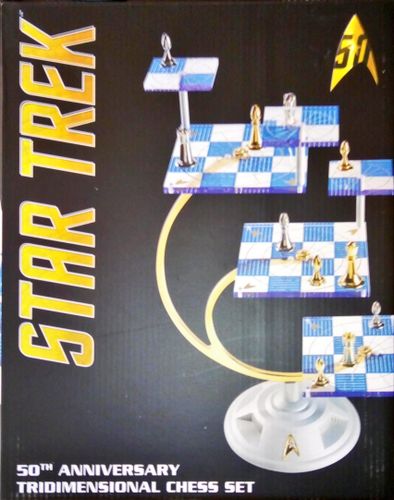|
Advertisement
|
Tridimensional chess

DescriptionTri Dimensional Chess, or tri-d chess was inspired by a stage property created by Irving A Feinberg for use in the Star Trek television program. While it appeared or was referenced in six episodes (Where No Man Has Gone Before, Charlie X. Court Martial, By Any Other Name, Whom Gods Destroy (dialogue only), Day of the Dove) no rules were ever developed for the game during the original run of the show. However, it did appear to be a two-player only game played with with standard chess pieces having (when viewed in plan) standard chess moves albeit on a multi-level play area. The play area consists of three chequered 4x4 boards, called levels, mounted at different heights so that the bottom level overlaps the middle level by 2 rows at one end and the top level overlaps the middle by 2 rows at the other end. Additionally, four 2x2 boards, called attack boards, are mounted on columns that may be fitted at any of the four corners of the three main levels. These attack boards may be moved around during play. Due to the overlap, all the boards are transparent. When viewed from above, the square colour of one level or attack board matches the colour and of those above and below (e.g. colourless above colourless, coloured above coloured; the colourless squares are called white and the coloured are called black in standard terminology). However, in the television series (e.g., By Any Other Name) the top level is oriented so that the left hand square of the side nearest the camera is red while the corresponding square of the middle and bottom levels are both colourless meaning this top down perspective of matching colours above colours was not based on the tv show. Outside of the tv show, rules for the game were first hinted at in the 1975 Ballantine Books in Franz Josef Schnaubelt's Star Trek Star Fleet Technical Manual but there is nothing close to a playable game explained. Encouraged by Schnaubelt, chess player and Star Trek fan Andrew Bartmess published a full set of rules of play. Since then numerous rule sets have been created including those by Jens Meder which include rules for tournament play (largely meaning rules on arbitration, use of a chess clock, official notation, etc.) and the official rules of the World Tri Dimensional Chess Federation written by military fighter pilot John Hawkins ostensibly partially inspired by aerial combat tactics. The most notable difference between the various sets of rules are to do with the attack boards and vertical movement of pieces. For example, do the attack boards always stand above the levels, or may they be "inverted" to hang as pendants below the levels? Can they move with just one pawn or with any other single piece? When viewed in plan, do pieces block movement for all levels or can the moving piece travel on one level if the other piece is on a different level? Can pieces move just vertically or must they always have least some horizontal component? Lesser differences between rules sets include promotion (e.g., does an attack board above the pawn mean the pawn does not promote) and castling (i.e., kings and rooks start on the attack boards, do they just swap spaces or does one piece move to the main level). While Tri-D chess bears similarity to the 3-D Chess Game from Lynn R Johnson, the first episode featuring the Tri-D chess set aired in 1966 while Johnson's game was not published until 1967. Game DiscussionsAdd CommentYou need to be logged in to comment. Insert Bullet List Please enter at least one item. Item: Item: Item: Item: Item: Insert Numeric List Please enter at least one item. Item: Item: Item: Item: Item: Insert Link Please enter the link of the website Optionally you can add display text Insert Email Please enter the email address Optionally add any display text Insert Image Please enter the link of the image Insert YouTube Video Please enter the link of the video Marketplace | ||||

Comments (0)